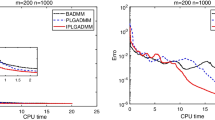Abstract
We consider a modification of a path-following infeasible-interior-point algorithm described by Wright. In the new algorithm, we attempt to improve each major iterate by reusing the coefficient matrix factors from the latest step. We show that the modified algorithm has similar theoretical global convergence properties to those of the earlier algorithm while its asymptotic convergence rate can be made superquadratic by an appropriate parameter choice.
Similar content being viewed by others
References
J. Ji, F.A. Potra and S. Huang, “A predictor-corrector method for linear complementarity problems with polynomial complexity and superlinear convergence,” Reports on Computational Mathematics No. 18, Department of Mathematics, University of Iowa, Iowa City, IA (1991).
J. Ji, F.A. Potra, R.A. Tapia and Y. Zhang, “An interior-point algorithm with polynomial complexity and superlinear convergence for linear complementarity problems,” Report No. 91-23. Department of Mathematical Sciences. Rice University, Houston, TX (1991).
N.K. Karmarkar, J.C. Lagarias, L. Slutsman and P. Wang, “Power-series variants of Karmarkar-type algorithms,”AT & T Technical Journal 68 (1989) 20–36.
M. Kojima, S. Mizuno and A. Yoshise, “An\(O(\sqrt n L)\) iteration potential reduction algorithm for linear complementarity problems,”Mathematical Programming 50 (1991) 331–342.
I.J. Lustig, R.E. Marsten and D.F. Shanno, “On implementing Mehrotra's predictor-corrector interior point method for linear programming,”SIAM Journal on Optimization 2 (1992) 435–449.
O.L. Mangasarian, “Error bounds for nondegenerate monotone linear complementarity problems,”Mathematical Programming 48 (1990) 437–445.
K.A. McShane, “Superlinearly convergent\(O(\sqrt n L)\)-iteration interior-point algorithms for linear programming and the monotone linear complementarity problem,”SIAM Journal on Optimization 4 (1994) 247–261.
S. Mehrotra, “Asymptotic convergence in a generalized predictor-corrector method,” Technical Report, Dept. of Industrial Engineering and Management Science, North-western University, Evanston, IL (1992).
S. Mchrotra, “On the implementation of a primal-dual interior point method,”SIAM Journal of Optimization 2 (1992) 575–601.
S. Mizuno, M. Todd and Y. Ye, “On adaptive step primal-dual interior-point algorithms for linear programming,”Mathematics of Operations Research 18 (1993) 964–981.
R.D.C. Monteiro and S.J. Wright, “A superlinear infeasible-interior-point affine scaling algorithm for LCP,”SIAM Journal on Optimization 6 (1996) 1–18.
J.M. Ortega and W.C. Rheinboldt,Interative Solution of Nonlinear Equations in Several Variables (Academic Press, New York, 1970).
F.A. Potra, “OnQ-order andR-order of convergence”,Journal of Optimization Theory and Applications 63 (1989) 415–431.
F.A. Potra, “An O(nL) infeasible-interior-point algorithm for LCP with quadratic convergence”, Reports on Computational Mathematics No. 50, Department of Mathematics, University of Iowa, Iowa City, IA (1994).
F.A. Potra and R. Sheng “Predictor-corrector algorithms for solvingP *-matrix LCP from arbitrary positive starting points,” Reports on Computational Mathematics No. 58. Department of Mathematics, University of Iowa, Iowa City, IA (1994).
S.J. Wright, “A path-following infeasible-interior-point algorithm for linear complementarity problems”,Optimization Methods and Software 2 (1993) 79–106.
S.J. Wright, “An infeasible-interior-point algorithm for linear complementarity problems,”Mathematical Programming 67 (1994) 29–52.
S.J. Wright, “A path-following interior-point algorithm for linear and quadratic optimization problems,”Annals of Operations Research, to appear.
Y. Ye and K. Anstreicher, “On quadratic and\(O(\sqrt n L)\) convergence of a predictor-corrector algorithm for LCP”,Mathematical Programming 62 (1993) 537–552.
D. Zhang and Y. Zhang, “A Mehrotra-type predictor-corrector algorithm with polynomial complexity andQ-subquadratic convergence”,Annals of Operations Research, to appear.
Y. Zhang, “On the convergence of a class of infeasible-interior-point methods for the horizontal linear complementarity problem,”SIAM Journal on Optimization 4 (1994) 208–227.
Author information
Authors and Affiliations
Additional information
The work of this author was based on research supported by the Office of Scientific Computing, US Department of Energy, under Contract W-31-109-Eng-38.
The work of this author was based on research supported in part by the US Department of Energy under Grant DE-FG02-93ER25171.
Rights and permissions
About this article
Cite this article
Wright, S., Zhang, Y. A superquadratic infeasible-interior-point method for linear complementarity problems. Mathematical Programming 73, 269–289 (1996). https://doi.org/10.1007/BF02592215
Received:
Revised:
Issue Date:
DOI: https://doi.org/10.1007/BF02592215




